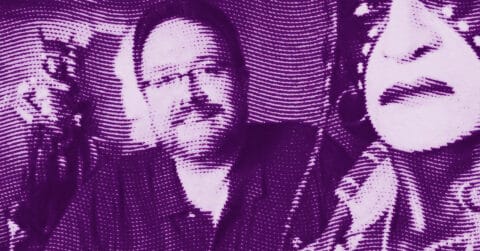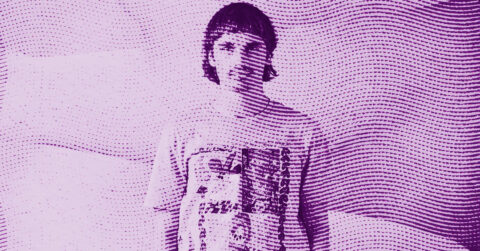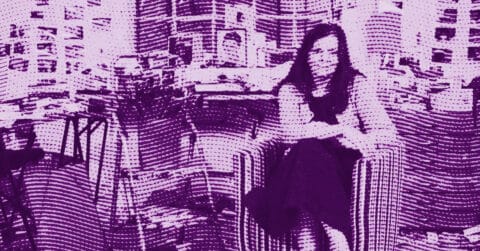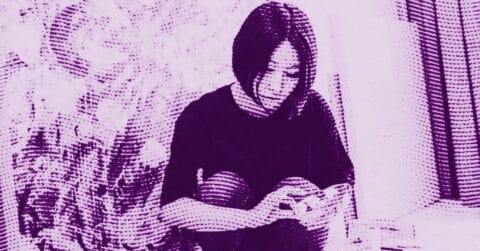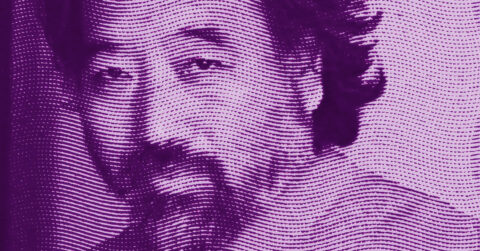Listen to me carefully, you bunch of snobs: there are still artists who dare to confront raw material without hiding behind the conceptual subterfuges of our time. Nikola Vudrag, a Croatian sculptor born in 1989, belongs to that rare breed who prefers the weight of steel to theoretical chatter. Trained at the academies of Rijeka and then Zagreb, where he was named best student in 2012, this heir of a line of metallurgists transforms iron into tangible meditations. His monumental sculptures, exhibited from Venice to Malta and Dubai, question our relationship to myth, form, and time with a boldness that stands out in the current landscape of contemporary art.
Vudrag’s work unfolds across several distinct series: the twelve labors of Heracles revisiting Greek mythology, geometric diamonds in Corten steel, the Net-Work series composed of thousands of welded metal bars, and monumental interventions in public spaces. His plastic vocabulary draws as much from geometry and physics as from ancient narratives, creating a sculptural language that rejects the ease of decoration. His Atlases and Prometheus, presented at the 60th Venice Biennale, embody this dual demand: formal rigor and symbolic depth. The artist does not seek to charm but to confront the viewer with essential questions about the human condition.
Plato haunts Vudrag’s studio, even if the sculptor does not always explicitly name him. The Platonic distinction between the world of ideas and that of sensory appearances finds an unexpected resolution in his work. When Vudrag creates his luminous diamonds, where light bursts from the interstices of a rusted steel shell, he does not settle for a formal game: he materializes the passage from the intelligible to the sensible. These sculptures become operative metaphors of the theory of forms. Steel, a raw and industrial material, serves as a mold for a light that represents the idea itself. By day, these works reveal their raw structure, their visible welds, their earthly heaviness. By night, the inner light transforms them into geometric outlines, pure luminous abstractions that seem to defy their own materiality.
This dialectic between matter and idea runs through all of Vudrag’s production. In his Apples of the Hesperides, exhibited at the first Malta Biennale, light does not decorate: it constitutes the very meaning of the work. The artist explicitly evokes Plato and Aristotle when he describes his creative process, acknowledging that “only the imaginary world of ideas can attain perfect form” while our reality necessarily remains imperfect. This philosophical lucidity led him to invert his approach: rather than vainly pursuing perfection in positive form, he creates metal shells that shape emptiness, allowing light, that old Platonic metaphor for knowledge, to inhabit negative space. The result produces a striking effect: monumental and rough forms by day, elegant light drawings by night, as if the Idea literally emerged from matter.
The systematic use of Corten steel reinforces this philosophical dimension. Vudrag likes the irony of this material that protects itself through its own corrosion, turning what usually destroys metals into a preservation mechanism. He describes this mixture of noble and ordinary metals as “the blood of the earth, something like ichor, that ethereal fluid from Homeric myths known as the blood of gods and titans” [1]. This quasi-animistic conception of the material goes beyond poetic anecdote: it places the sculptural work within a cosmogony where the matter itself possesses a mythological dimension. The steel carries a memory and intentionality that resonate with the ancient stories that Vudrag revisits. Atlas bearing the weight of the world, Prometheus chained for stealing fire: these mythological figures find in the patinated Corten a medium that amplifies their symbolic charge.
Monumental sculpture has a long and tumultuous history, marked by kitschy commemorative monuments, totalitarian celebrations, and spectacular failures. Vudrag situates himself within this centuries-old tradition while reorienting it toward contemporary concerns. His monument to Nikola Tesla, this “transmission line sculpture” twelve meters high weighing two tons, combines functionality and aesthetics, urban design and national heritage. This type of public work demands formidable technical mastery: static calculations, foundations of twenty cubic meters of concrete, coordination of teams of ten people or more. Few contemporary sculptors can claim such an ambition of scale. Most prefer ephemeral installations and discreet interventions, as if monumentality had become suspect by principle.
Yet, Vudrag claims this scale without complex. His four-meter Poseidon, standing facing the sea, his interactive violin allowing passersby to play notes, his Enso in the main square of Čakovec: these urban interventions reject postmodern modesty. They assert that sculpture can still structure public space, create symbolic landmarks, evoke collective experiences. This ambition paradoxically brings him closer to American minimalists, notably Richard Serra, whose material and visual proximity several critics have underlined. Vudrag’s Corten steel plates, their characteristic patina, their imposing physical presence maintain an obvious dialogue with Serra’s work. But whereas Serra favored pure abstraction and the phenomenology of spatial perception, Vudrag reintroduces figure and mythological narrative.
This difference deserves attention. The minimalism of the 1960s-1970s had excluded any external reference to the work itself: the sculpture spoke only of itself, of its weight, volume, relation to space. Vudrag inherits this formal lesson, rigorous geometry, frankness of materials, rejection of pictorial modeling, but contradicts it in its very principle by reinjecting symbolic content. His polygonal animals, mythological figures, masks from the Net-Work series remain recognizable despite their geometric treatment. The artist thus produces a bold synthesis between minimalist refinement and representative tradition, between contemporary abstraction and ancient narration. This position obviously exposes him to criticism from both camps: too figurative for abstraction purists, too geometric for lovers of classical sculpture.
The question of metallurgical tradition adds an additional layer to this issue. Vudrag regularly emphasizes his family lineage: his father and grandfather were metallurgists, and he learned their know-how from childhood through play. This generational transmission of technical gesture is not trivial at a time when most artists subcontract the fabrication of their works to specialized workshops. Vudrag himself shapes the steel in his three hundred and fifty square meter workshop, a former industrial site transformed into a creative space. This physical proximity to the material, this intimate knowledge of its properties and resistances directly informs the forms he produces. The artist does not design sculptures for others to execute: he thinks as much like a blacksmith as a sculptor, partially letting the material guide the creative process.
This approach stands in stark contrast to the increasing dematerialization of contemporary art. While some artists are content to produce concepts, instructions, or digital files, Vudrag advocates an archaic and salutary conception of art as a physical confrontation with matter. His hands bear the marks of this struggle: welding burns, cuts, calluses. His entire body participates in the creation of monumental works that require strength and endurance. This artisanal dimension might seem retrograde if it were not accompanied by openness to contemporary technologies. Vudrag uses 3D scanning to document his sculptures, create digital models, plan versions at different scales. He integrates LED lighting systems into certain pieces, exploiting the possibilities of digital technology without abandoning the primacy of manual work.
His recent career reflects growing international recognition. The sale of the work “Sumeran Maiden from the NET-WORK cycle (2023)” at a charity auction in Warsaw for nearly 190,000 euros hammer price created a sensation, establishing his market value. This dizzying amount might arouse suspicions: doesn’t the market often favor the most insipid artists? But in Vudrag’s case, commercial valuation accompanies legitimate institutional recognition. His participations in the Venice and Malta biennials, his public commissions in Croatia, his exhibitions in established Parisian galleries, his role as creator of Croatian euro coins: this résumé admits no contestation.
The artist also proves aware of the dangers of commercial success. Asked about his future projects, he mentions his need to regularly withdraw to his workshop, away from media noise, to regain “solitude, introspection, and old books, walking almost on the fine line between reason and madness in search of a new personal “Eureka!” moment” [1]. This formulation reflects a keen understanding of the creative process as a precarious balance between rational control and inspired abandonment. Vudrag reads extensively, philosophy, mythology, and history of sciences, and this erudition nourishes his work without ever burdening it with sterile pedantry. His sculptures first speak visually, through their physical presence and plastic force, before delivering their layers of meaning to spectators who take the time to decipher them.
The question of myth remains, omnipresent in his work. Why this systematic recourse to Greek tales? Vudrag himself answers: “If history has repeated itself in various forms for thousands of years, there must be a certain message that deserves attention. Ultimately, those I have deciphered and understood have helped me better understand myself and the world around me” [1]. This justification might seem naive if one forgot that Greek myths indeed constitute an inexhaustible reservoir of psychological archetypes and universal narrative structures. Atlas bearing the world, Prometheus stealing fire, Heracles accomplishing his twelve labors: these figures embody fundamental human experiences that still resonate today. The sculptor does not treat them as archaeological curiosities but as matrices of meaning still active.
His interpretation of the Atlas-Prometheus duo illustrates this living approach to myth. Atlas becomes the hand emerging from the ground and gripping a classical column, symbolizing the burden and the strength needed to carry the world. Prometheus is reduced to a hand pulled by a chain, representing rebellion and the pursuit of knowledge at the cost of terrible consequences. Vudrag explicitly connects these two figures to the human destiny: Atlas carries the head, seat of the ideal world; Prometheus represents the conscious spirit inhabiting that head. Their shared destiny of eternal stress and pressure constitutes, according to the artist, a universal human experience. This existentialist reading of ancient myths avoids the pitfall of simplistic allegory: the sculptures do not mechanically translate a pre-established meaning but open a space for reflection on our condition.
The scope of Vudrag’s production impresses as much as its quality. In about ten years of career, he has created dozens of public sculptures, participated in more than sixty exhibitions, and won several awards. This sustained work pace demands rigorous workshop organization, precise management of orders and deadlines, skills that go far beyond the strictly artistic realm. Vudrag also proves to be an entrepreneur, manager, and communicator. His media ease, his capacity to explain his work in an accessible way, his skill in negotiating with institutions and collectors: these extra-artistic talents have certainly contributed to his rapid rise. Some purists may see this as a concession to market demands, but this criticism seems unfair. An artist who wishes to realize monumental sculptures in public spaces must necessarily master these pragmatic dimensions.
The moment arrives to draw some threads. Nikola Vudrag’s work fits within a multise-cular sculptural tradition while bending it according to contemporary lines of force. His fidelity to steel and manual work, inherited from a family transmission, combines with a keen awareness of the philosophical and aesthetic stakes of our time. The dialogue he establishes between minimalism and figuration, between geometric abstraction and mythological narration, between monumentality and intimacy creates a singular space in the field of current sculpture. Neither nostalgic traditionalist nor provocative avant-gardist, Vudrag occupies a middle position that might seem uncomfortable but ultimately proves fruitful. He shows that it remains possible to sculpt matter ambitiously without renouncing conceptual depth, to create monumental public works without sinking into kitsch, to draw from ancient myths without falling into dusty academicism.
His use of light as a sculptural element stems from the Platonic observation of the impossibility of achieving formal perfection in the sensible world to invent an original solution: the negative form, the metal mold that holds the light. This inversion reflects a plastic intelligence that does not merely illustrate philosophical ideas but makes them work within the matter itself. The protective rust of Corten steel, which he compares to the blood of the gods, ceases to be a mere chemical property to become an operative metaphor of time that preserves rather than destroys. These semantic shifts, these symbolic condensations constitute the very flesh of his work: they prevent his sculptures from being reduced to transparent allegories while conferring upon them a depth of meaning that goes beyond mere physical presence.
Nikola Vudrag is still a young artist. He has, if fate permits, several decades of creation ahead of him. It is difficult to predict the directions his work will take: other materials, other scales, other themes? The artist himself enthusiastically mentions the works of Heracles that remain to be completed, suggesting that he has not exhausted the possibilities of the mythological vein. But whatever direction he chooses, he will have already proven that a 21st-century sculptor can still confront steel and myth with a demand that refuses the conveniences of the time. This uncompromising pursuit of a personal vision, this ability to combine formal rigor and symbolic generosity, this stubbornness to sculpt rather than to discourse: that is what deserves to be praised in Nikola Vudrag. The rest, the auction records, prestigious biennials, and distinctions, is but foam on the surface of patient and obstinate work that carves its furrow in steel as well as in time.
- Julien Delagrange, “A Conversation with Nikola Vudrag”, Contemporary Art Issue, 2024



